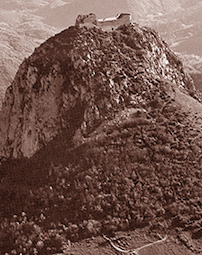
“Where is the Gral kept today? Perhaps it is kept in the depths of the heart”.
For years, Otto Rahn travelled and investigated the region. It is true that he was a precursor of modern speleology. His book is undoubtedly a document about the legend, as well as this science. It is based on the Gral poem Parzival, by Wolfram von Eschenbach (which also served as the base for Parsifal by Wagner), and on the philology and literature that exist about the Cathars. He conversed with the scholars and mystics of Languedoc, he examined the archives, he left nothing to investigate. Later, he continued searching around Europe and wrote a book that today is “forbidden literature”: Lucifer´s Court. It is impossible to find this book in bookshops or libraries. It has mysteriously disappeared. It was also his last book. Otto Rahn committed suicide, in the manner of his heroes, no long before the start of the WWII. Apparently, he voluntarily froze near a Tyrolean mountain, in the Alps, on the current border of Germany and Austria. Much later, he was found dead, sitting on a rock, with his head resting on one hand, as he was peacefully, contemplating the glaciers. Otto Rahn was just thirty nine years old.
A French man
I have talked at length and maintained correspondence with René Nelli a scholar of Catharism and of the culture and literature of the Troubadours from Provence; the author of Le Phénomene Cathare, L´Erotique des Troubadours among other important works. It was through him that I came to know about Otto Rahn.
At his home in Carcassonne, surrounded by relics, and rare documents written in ancient Occitan and in an atmosphere which reminded the ancient Occitan civilization, he told me the following: “If Germans had won the war they would have rebuilt the castle of Montsegur. Upon completion of the seven hundred years of the fall of Montsegur on March 16th, 1944 a German plane flew over the ruins of Montsegur and drew the Celtic cross in the sky. Who was in that plane? What was the possible connection that existed between National Socialisms and the Cathars, the “Perfects” and the “Pures”, who believed that this world was a work of Satan and who only aspired to leave it, even committing suicide, the “endura” (fast, extreme penitence)?”
Recently, a book appeared New Cathars for Montsegur (Nouveaux Cathares pour Montsegur) by Saint-Loup (author of The White King of Patagonia, The Night Begins in Cape Horn, From Aconcagua to Cape Horn, The Heretics, The History of the SS division Charlemagne, The Volunteers, History of the Legion of French Volunteers, The Nostalgics, etc.), which aims to provide the answer. It says that it was Alfred Rosenberg, the philosopher of National Socialism, the author of The Myth of the Twentieth Century who flew over Montsegur.
Saint-Loup states that Otto Rahn after publishing the book Crusade Against the Grail, that is to say after 1933, became a member of Hitler’s Black SS –a secret and initiatory Order in the style of the Temple Order– and that following instructions by Rosenberg, he returned to the Pyrenees to search the Gral in the caves, where the Cathars hid in the XIII century after the fall of Montsegur.
Also according to Saint-Loup, Otto Rahn did not find the Gral.
It is hard to tell how Saint-Loup obtained such information. There are coincidences, of a rather external type (the black robes of the Cathars and of the SS, the castle of Montsegur and the Eagle´s Nest of Hitler, in Berchtesgaden, etc.). It is true that it is not known, even today, what Catharism really was and what was behind the SS Black Order. The most important documents of the Cathars would have been burned by the Inquisition (their tradition was mostly oral, like the Vedic) or would have voluntarily disappeared. The same happened, for instance, to the SS documents and of those of the National Socialist research centers, established in Munich, which concerned magic. It is known that a young professor, at the University of Vienna, a scholar on magic, a serious researcher in the history of this art, was transferred by the Germans to Munich to one of their Institutes in Munich and he did not return to Austria after the end of the war. Nothing was ever heard about him again.




